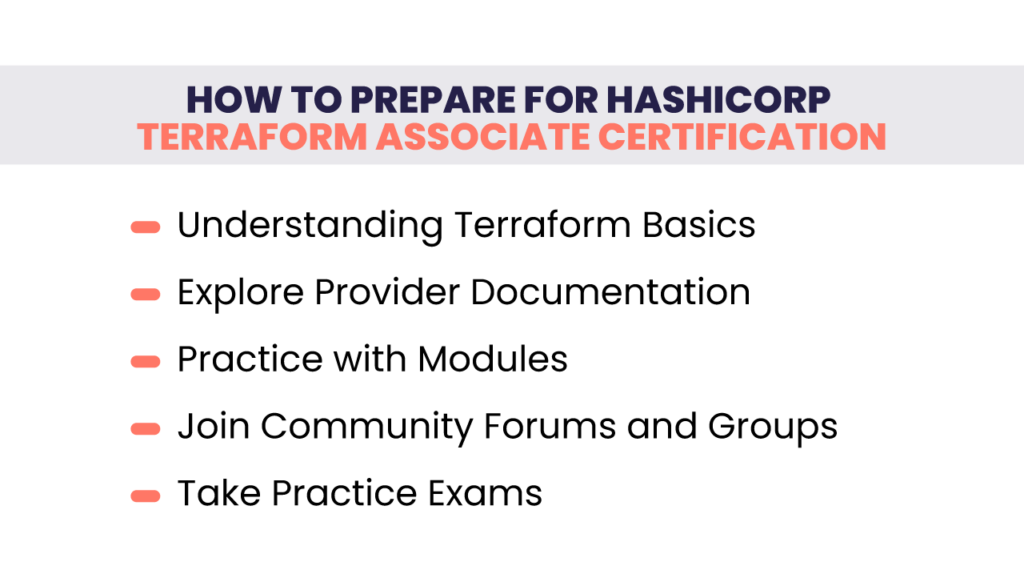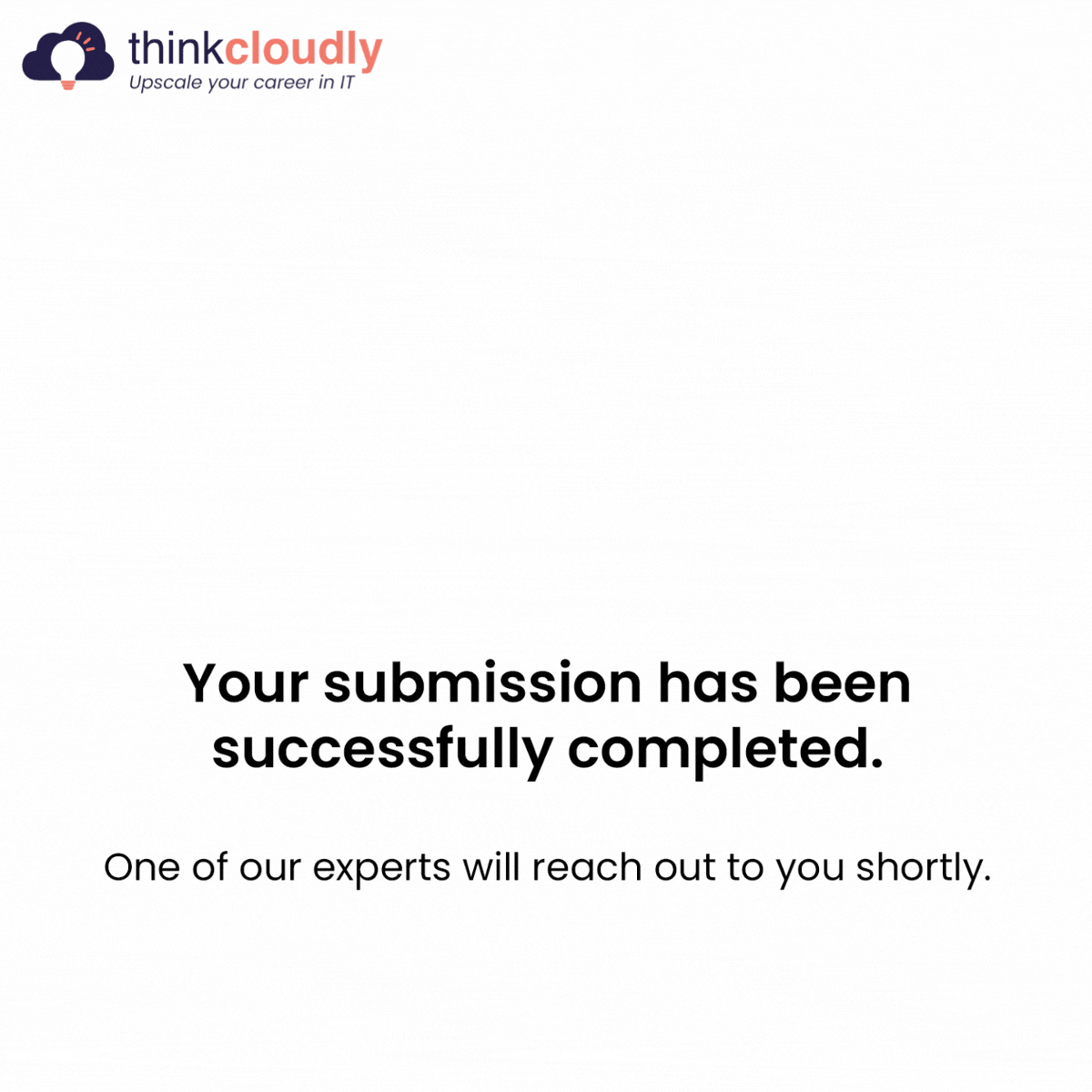Introduction
Preparing for the HashiCorp Terraform Associate Certification requires an organized strategy that addresses multiple areas of Terraform usage, best practices, and infrastructure as code (IaC). The HashiCorp Terraform Associate Certification confirms your abilities as a Terraform practitioner. Below are 10 steps to prepare for HashiCorp Terraform Associate Certification. By following these steps and dedicating time and effort to learning and practicing Terraform, you can effectively prepare for the HashiCorp Terraform Associate Certification.
Steps to Prepare for HashiCorp Terraform Associate Certification
The 10 steps given below provide you with a structured approach to your preparation for HashiCorp Terraform Associate Certification
Step-1: Understanding Terraform Basics
- Learn about the key concepts of Terraform: infrastructure as code (IaC), providers, resources, and state management.
- Explore basic Terraform setups like variables, modules, and outputs.
- Discover Terraform’s CLI commands to startup, plan, apply changes, and manage state.
Step-2: Hands-On Experience
- Develop your ability to create basic Terraform configurations for deploying networking components, virtual machines, and storage.
- Gain proficiency in configuring Terraform to deploy virtual machines, storage, and networking components.
- Become proficient in setting up Terraform for networking, storage, and distributed virtual machines.
Step-3: Study Official Documentation
- Thoroughly examine the standard Terraform documentation, with an emphasis on the Terraform CLI, configuration syntax, and provider-specific resources.
- Pay special attention to resource types, provider documentation, and Terraform setup language for AWS, Azure, Google Cloud, etc.
- Know the conventions, best practices, and suggested workflows listed in the documentation.
Step-4: Explore Provider Documentation
- Check the provider documentation in more depth for the cloud platforms or services you’re using (such as AWS, Azure, and Google Cloud).
- Identify resource availability, authentication processes, and provider-specific configurations.
- To use Terraform efficiently in different environments, learn about the features, restrictions, and recommended practices that are unique to each provider.

Step-5: Learn Version Control
- Recognize how important version control tools like Git are to maintaining a Terraform setup.
- Try branching, merging, and using Git repositories to version your Terraform code.
- Learn how to use Git-based workflows for Terraform projects to collaborate with team members.
Step-6: Practice with Modules
- Learn about Terraform modules and how they help with abstraction, encapsulation, and code reuse.
- Create your own modules for standard infrastructure components or patterns.
- Learn how to use and modify the community-created Terraform Registry module to suit your needs.
Step-7: Master State Management
- Learn the importance of Terraform state files and their use in monitoring metadata and resource dependencies.
- Discover how to set up a backend system like Amazon S3, Azure Blob Storage, or HashiCorp Consul for remote state storage.
- Use state management solutions, such as migration planning, isolation, and state locking.
Step-8: Take Practice Exams
- Use online practice tests and example questions to evaluate your knowledge and pinpoint areas for development.
- To help you prepare more effectively for the official certification exam, educate yourself about the format, question types, and time limits.
- To gain a deeper knowledge of Terraform ideas and use cases, look at the explanations of both the right and wrong answers.
Step-9: Join Community Forums and Groups
- Participate in forums, discussion groups, and social media to interact with the Terraform community.
- Join online communities by posting questions, sharing expertise, and benefiting from others’ experiences on forums like HashiCorp Discuss, LinkedIn Groups, and Reddit r/Terraform.
- Attend online seminars, meetups, or webinars about Terraform to learn about the latest trends and best practices.
Step-10: Stay Updated with Official Training Resources
- Check out the official training programs offered by HashiCorp, including webinars, workshops, and online courses covering both basic and advanced Terraform topics.
- To get structured learning and practical experience, consider signing up for HashiCorp-approved workshops or training programs.
- For information about new Terraform features, improvements, and best practices, keep an eye on HashiCorp’s release notes, blog entries, and official announcements.
Benefits of Hashicorp Terraform Associate Certification
- Certification in Terraform demonstrates experience in infrastructure automation.
- Improves work prospects and opens new career paths in cloud and DevOps businesses.
- Enables enterprises to save time and resources by deploying and managing infrastructure more efficiently.
- Certified professionals generally demand higher compensation because of their specific abilities and certifications.
- Equips you with capabilities that can be transferred to multiple cloud platforms and scenarios, promoting versatility.
- By using automated infrastructure deployment, enterprises can reduce errors, improve security, and maintain compliance.
- It keeps you at the forefront of cloud technology trends and prepares you for future advancements in infrastructure automation
Conclusion
In this blog, we have shared the best way to start a career for HashiCorp Terraform Associate Certification. And we have also shared some Terraform certification benefits to tell you why you should prepare for this certification. If you still have any doubts, you can contact us












No comment yet, add your voice below!